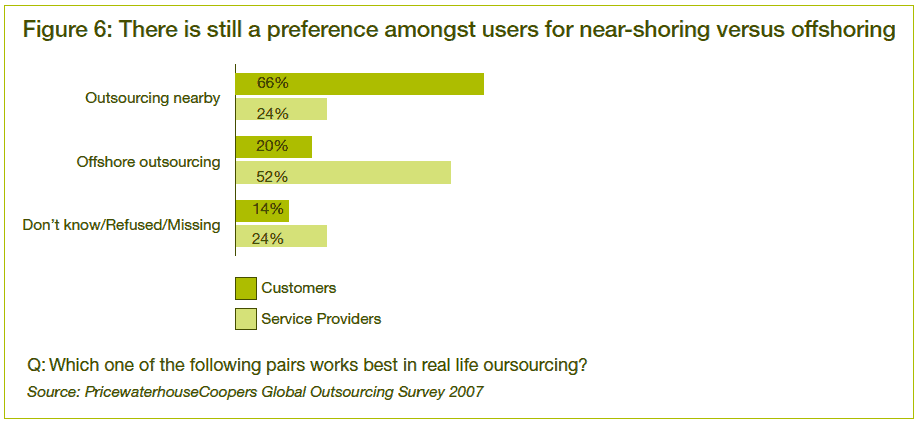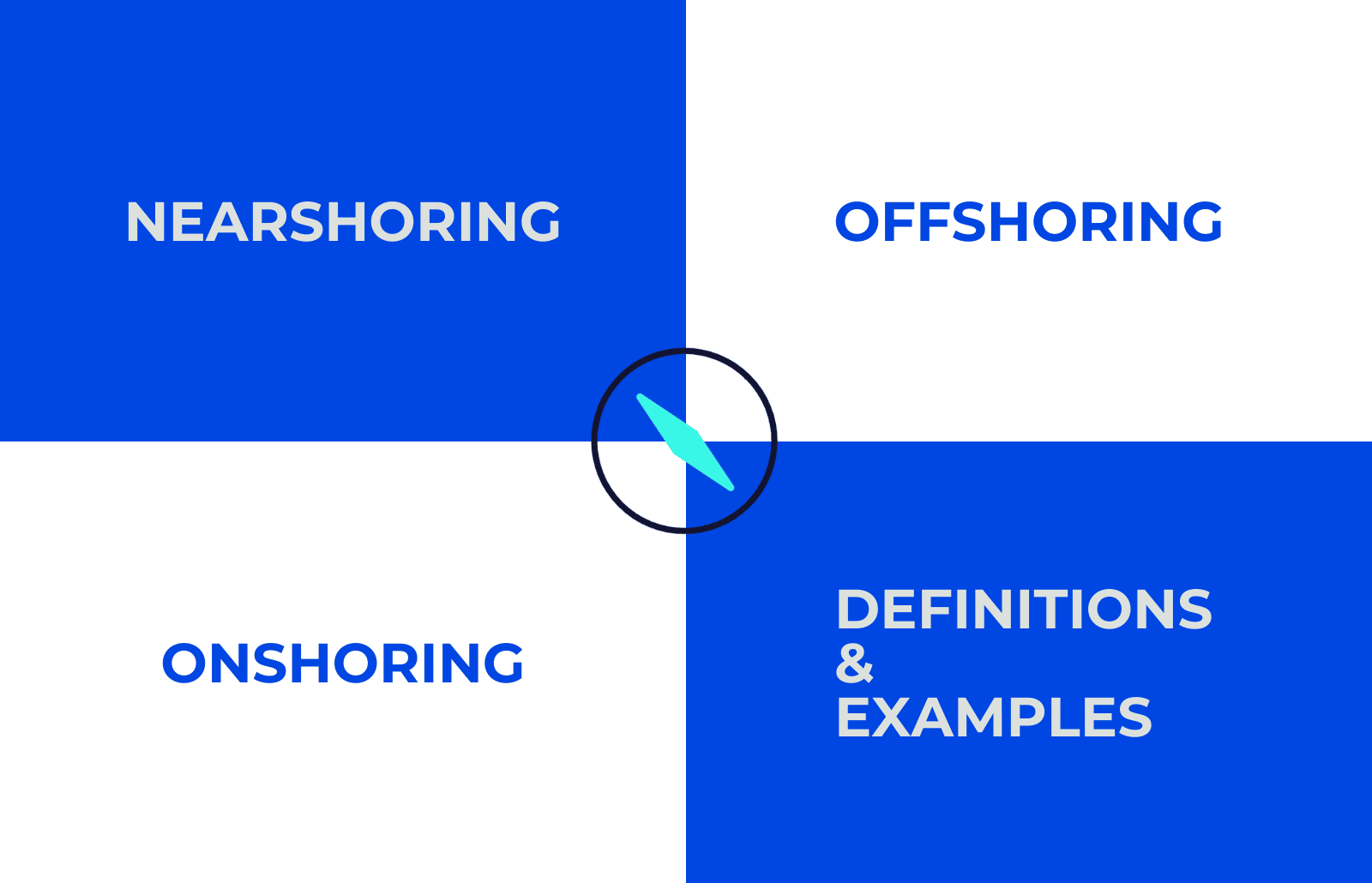So, you are looking to scale up your engineering team and get more young blood flowing into your organization. However, for various budgetary, strategic, or logistical reasons, you are not too keen on the idea of hiring new in-house employees. What do you do?
One word: outsourcing.
It sounds simple enough. But if that’s your first foray into the outsourcing industry, you may not yet know where to outsource software development — or even how to outsource software development to begin with.
The main thing you should know is that there are three main outsourcing models: nearshoring, offshoring, and onshoring. In this article, we’ll define each one in turn, providing you with a handy roundup of their respective pros and cons so you can make informed decisions about the future of your company.
And here’s the best part: while we will look at outsourcing, a.k.a. staff augmentation, primarily from the perspective of software development, the overarching principles are valid across industries. With just a few tweaks here and there, you can use the main takeaways from this article to gain a competitive advantage in various businesses.
What Is Nearshoring?
Nearshoring Definition
Under the nearshore outsourcing model, you delegate specific tasks or entire projects to a software development team in a nearby country. Typical nearshoring examples would be:
- A company based in the United States outsourcing to a third-party in Mexico.
- A customer in Germany delegating work to an extended development service provider in Poland or elsewhere in Europe.
What Are the Benefits of Nearshoring?
The main advantage of this model is the proximity of the nearshoring partner. The time difference, if any, is typically no more than a couple of hours. What’s more, with the nearshoring location right across the border, it’s relatively easy to have in-person meetings when needed — and the travel costs shouldn’t make too big of a dent in your budget.
All that makes it possible for the nearshore developers to collaborate closely with your in-house staff in real time. It also allows you to have tight oversight over all aspects of the development process.
Furthermore, nearshore experts are usually more cost-effective than domestic ones, and the lower rates don’t come at the expense of either credentials or expertise. And speaking of expertise — nearshoring gives you access to a much larger and more diverse talent pool than hiring locally.
Given the many advantages of nearshoring, it should come as no surprise that users of outsourcing services have a clear preference for nearshoring over offshoring. 66% of the customers polled in the PWC Global Outsourcing Survey 2007 indicated a clear preference for nearshore versus offshore outsourcing.

Source: PWC Global Outsourcing Survey 2007
Nearshoring Case Studies
For a real-life case study of a successful nearshore software project, check out the story of our collaboration with Fexco, Ireland’s leading Fintech solutions and business services provider. And here you can read the personal account of Seán O’ Sullivan, CTO of the Dublin-based engage EHS, detailing his company’s experience with setting up a nearshore software development team in Spain.
What Is Offshoring?
Offshoring Definition
Offshore outsourcing is very similar to nearshoring — with the exception that the offshore team is typically located on another continent. Traditional offshoring locations include India, Ukraine, and various Latin American countries such as Argentina, Colombia, and Brazil.
What Are the Benefits of Offshoring?
Offshoring’s biggest advantage by far are the labor costs. The hourly rates of developers halfway across the globe are often significantly lower than those of both domestic and nearshore engineers.
While cost savings have always been a key consideration for users of outsourcing services, businesses have started prioritizing other objectives in recent years, including scaling faster, enhancing user experience and customer service, and achieving a faster speed to market.
However, the COVID-19 pandemic and the economic crisis it brought about have made sure that cost-effectiveness has once again taken center stage. The vast majority of the respondents in Deloitte’s Global Outsourcing Survey 2020 — a whopping 70% — said that cost reduction is their primary outsourcing objective. Back in 2018, cost optimization didn’t even make it in the top five!

Source: Deloitte Global Outsourcing Survey 2020
That said, offshoring is not all smooth sailing. This outsourcing model comes with a number of drawbacks, including considerable time differences, longer journey times, and higher travel costs. All that can have a negative impact on your business operations.
Depending on where your service provider is based, you may also face more pronounced cultural and language barriers. These pose additional risks and can disrupt the communication between your in-house and offshore teams.
Offshoring Case Studies
Zartis partnered with the US-based Valant, a leading provider of practice management and electronic health record solutions for behavioral mental health practitioners. Some of the offshore services we provided to Valant included:
- Helping our client access a larger pool of skilled workers in Europe that were much more cost-effective than US developers.
- Setting up a coherent team structure, including local Team Leads, in order to ensure a smooth collaboration, despite the time zone differences.
- Helping Valant identify the main weaknesses in its existent architecture.
- Migrating Valant’s core product from legacy software to a cutting-edge tech stack, including a single-page application with Angular 8, Typescript, and WebComponents.
- Working closely with Valant’s Product Development team to curate the new application’s UX.
What Is Onshoring?
Onshoring Definition
Onshoring is “domestic” outsourcing. It involves the transfer of your company’s software development to non-metropolitan — and therefore more affordable — locations within your own country. An example would be outsourcing development from your office in Central London to, say, Kent.
What Are the Benefits of Onshoring?
Migrating some or all of your development process from big urban centers to less up-and-coming areas can certainly help curb your expenses. However, the cost reduction will likely be nowhere near that associated with offshoring and even nearshoring. On the flip side, though, you get to benefit from working under the same rules and regulations and a nearly identical work culture. Plus, there are absolutely no language or cultural barriers.
But why is onshoring more expensive than nearshoring?
It’s simple, really. Onshoring usually only makes sense for companies based in large and expensive metropolitan areas like London or Paris. In such cases, onshoring to a nearby town will save you money. However, it will still be more expensive than nearshoring to less developed economies such as Spain or Portugal, for example.
Onshoring will also be of limited use if you are looking to access a larger pool of international talent. And with more and more companies turning to remote work in a post-pandemic world anyway, demand for onshoring may well decrease, particularly in software development. What’s to stop a software development company to simply hire engineers directly and have them work from home?
Nearshoring vs Offshoring
The truth is that neither outsourcing model offers a one-size-fits-all solution. Both have their pros and cons, and which one would be a better match for you depends on a host of factors, including your budget, location, business goals, and the project type.
Offshoring is often a good fit for smaller or one-off projects, as well as tasks that require minimal supervision. It can also work great for companies with a limited hiring budget or those interested in a 24-hour production cycle. In contrast, businesses looking to build close, long-term collaboration and develop more complex products tend to outsource closer to home.
Next Steps
Want to learn more about software outsourcing? Do this:
- Check out our in-depth comparison between nearshore and offshore outsourcing.
- Read a real-life case study on outsourced software development.
- Find out what is the best country to outsource your software development.
- Be alert to situations where you may need an extended development team.
- Talk to Zartis to learn how we can assist your company on your outsourcing journey.


